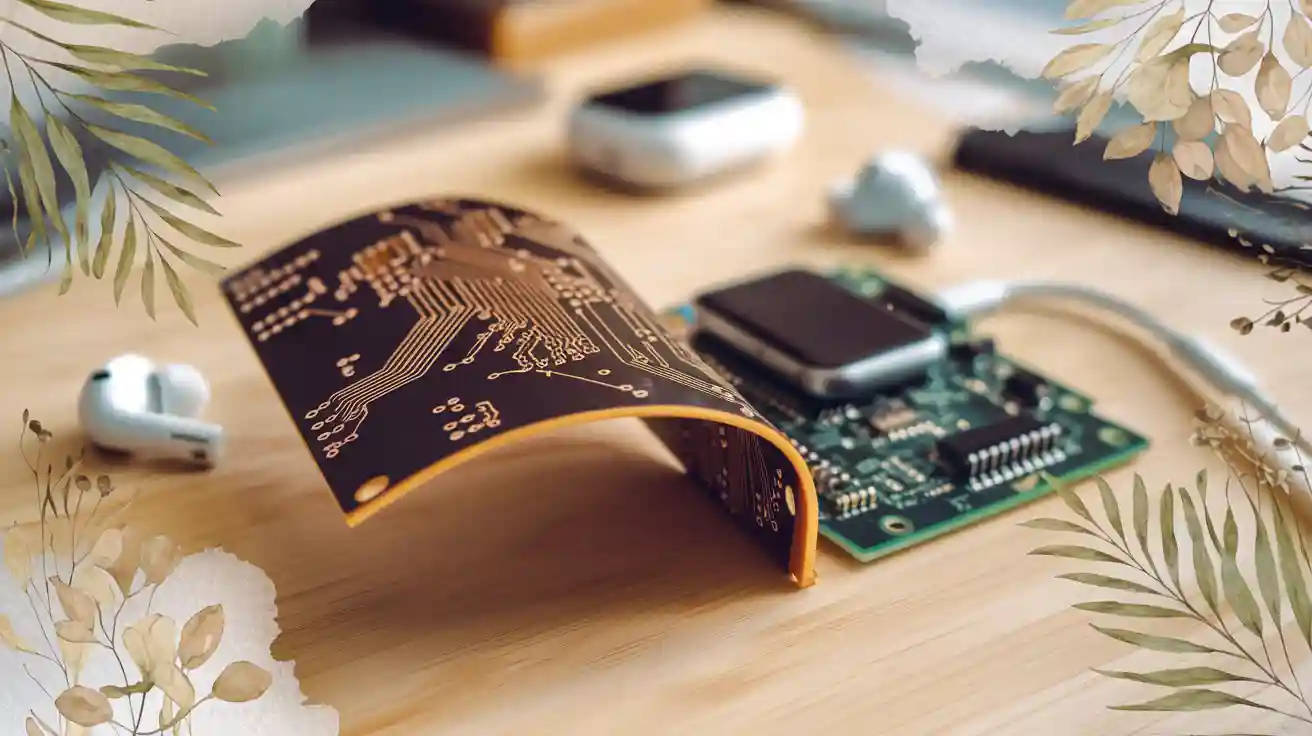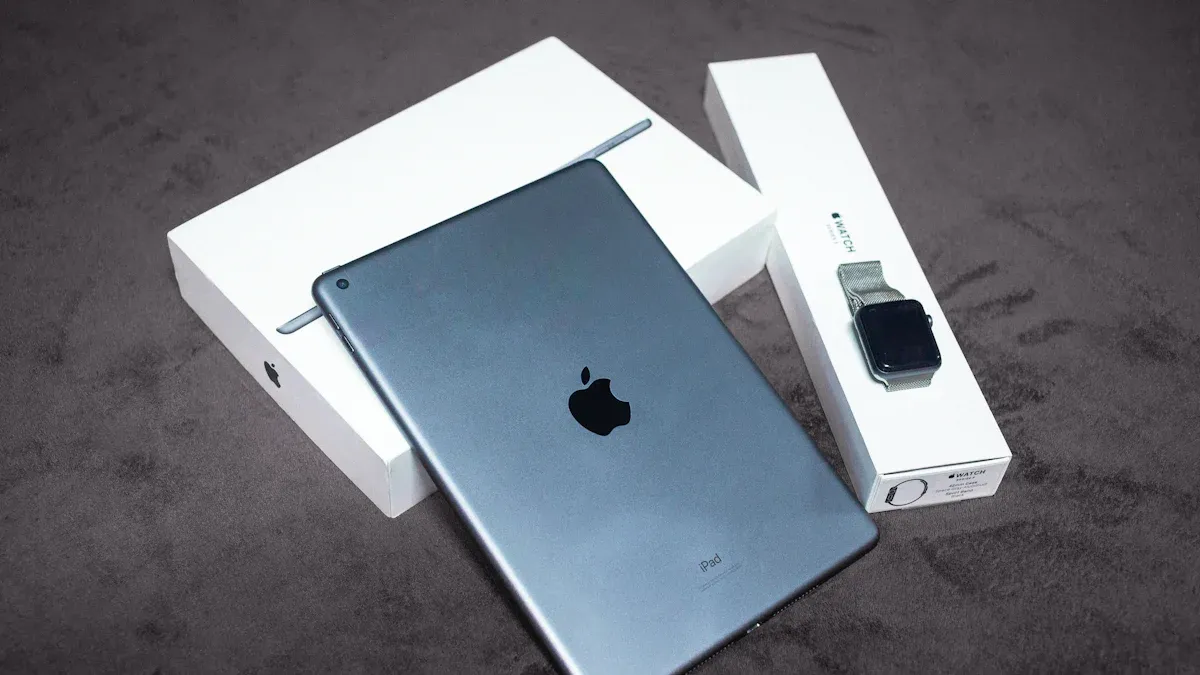Consumer electronics flexible circuit boards

Flexible circuit boards, or flex PCBs, are thin and light. They are made to bend and twist without breaking. These special features make them very useful in modern electronics. Unlike stiff boards, flexible ones help make devices smaller and lighter.
The market for these boards shows their importance. It was worth $70.8 billion in 2025. By 2035, it is expected to grow to $117.5 billion. This is a yearly growth rate of 5.1%. The growth comes from the need for smarter and better devices. Cool gadgets like foldable screens and wearables use flexible boards. These boards make amazing designs possible.
- Flexible circuit boards are not just parts; they drive new ideas in electronics.
Key Takeaways
- Flex PCBs are thin and bendable, perfect for modern gadgets like phones and smartwatches.
- They save space and make devices lighter, helping create cool designs like foldable screens and tiny tools.
- These boards are tough and can handle bending and shaking, which is important for cars and wearable tech.
- Flex PCBs cost more at first but save money later by making repairs and assembly cheaper.
- Flexible electronics are improving fast, with better materials and smaller parts leading to smarter and more useful devices.
What are flexible circuit boards?
Definition and features
A flexible circuit board, or flexible PCB, is a special type of circuit. It is made to bend and twist without breaking. Unlike stiff boards, flexible PCBs use thin materials like polyimide or polyester. These materials let the board fit into small spaces and odd shapes. You can find them in devices like smartphones, wearables, and medical tools.
One big advantage of flexible circuits is they reduce bulky wires. This helps make devices smaller and lighter. They also last longer by using fewer connectors, which often break in rigid boards. Flexible PCBs can also handle movement, making them great for foldable screens and wearable gadgets.
Types of flexible circuit boards
There are different types of flexible circuit boards, each for specific uses:
- Single-sided flexible PCBs: These have one conductive layer and are simple. They are used in basic devices like calculators or sensors.
- Double-sided flexible PCBs: These have two conductive layers for more complex circuits. You might find them in cameras or medical tools.
- Multilayer flexible PCBs: These have many conductive layers for advanced functions. They are used in high-tech devices like smartphones or aerospace tools.
- Rigid-flex PCBs: These mix rigid and flexible parts for the best of both. They are used in small devices needing strength and space-saving.
Each type has its own job, so pick the one that fits your device.
Comparison with rigid circuit boards
Flexible circuit boards are very different from rigid ones. Here's a simple comparison:
| Feature | Flexible Circuit Boards (Flex PCBs) | Traditional Rigid Designs (Rigid PCBs) |
|---|---|---|
| Flexibility | Very flexible, great for small and moving devices | Stiff and less able to bend |
| Size and Weight | Smaller and lighter with fewer wires and connectors | Bigger and heavier due to extra wiring |
| Cost | Costs more to make but saves money in assembly | Cheaper to make with standard materials |
| Design Complexity | Harder to design but more adaptable | Easier to design but costly to change |
| Performance in Stress | Not as strong in tough conditions | Stronger in stable environments |
Flexible PCBs are best for small, light, and adaptable devices. But rigid boards work better in tough and steady conditions.
Applications in consumer electronics

Flexible circuit boards are crucial for modern electronics. They are used in many devices, like phones and smart home gadgets. Let’s see how they improve these technologies.
Smartphones and tablets
Flexible boards are inside your phone or tablet. They help make devices thinner and lighter. Foldable screens are possible because of these boards. Flexible boards fit into small spaces, perfect for compact devices. They also last longer by using fewer connectors, which often break in rigid designs.
People want better phones and tablets. Flexible boards help by supporting cool designs and strong performance. High-quality cameras and fast processors work thanks to these boards.
Wearable devices
Wearables like fitness trackers and smartwatches use flexible boards. These boards make gadgets light and comfy to wear. They bend and twist to fit your wrist or body.
Flexible boards also make wearables work better. They support sensors for heart rate, steps, and sleep tracking. Wearables are popular for health and fitness. Flexible boards help create smaller and smarter designs.
IoT and smart home technology
Smart home devices and IoT gadgets use flexible boards. These boards are in things like smart thermostats and security cameras. They allow small and creative designs, making devices easy to use.
Flexible boards also make IoT devices more reliable. They handle movement and vibrations well. As smart home tech grows, flexible boards will be even more important. They help build the future of connected devices.
Other consumer electronics
Flexible circuit boards are key parts of many gadgets. They bend and fit into small spaces, making cool designs possible. These boards are found in devices that improve daily life and fun.
Gaming Consoles and Accessories
Gaming consoles use flexible circuit boards for better performance in small designs. These boards shrink internal parts, making consoles slim and easy to carry. Controllers and accessories, like VR headsets, also use flexible PCBs. They help sensors work well for smooth gaming and fun experiences.
Cameras and Imaging Devices
Digital cameras use flexible circuit boards to stay light and compact. These boards fit high-tech features like sharp sensors and zoom parts into tiny spaces. Flexible PCBs also make cameras tougher, so they handle movement and shaking.
Audio Equipment
Modern audio gear, like headphones and speakers, needs flexible circuit boards. These boards keep designs small while giving great sound quality. Wireless earbuds use flexible PCBs for features like noise blocking and Bluetooth.
Automotive Consumer Electronics
Cars today have lots of electronics, like touchscreens and safety tools. Flexible circuit boards fit into tight spots and handle shaking well. They are also important for electric cars, which need small and strong electronics.
- Tip: Flexible circuit boards are the heart of many gadgets you use. They help create new ideas in the electronics world.
Flexible PCBs keep making devices smaller, smarter, and better. As demand grows, they will be used in even more gadgets.
Benefits of flexible circuit boards
Space-saving design
Flexible circuit boards help make devices smaller and lighter. Their thin and bendable design fits into tight spaces easily. Unlike stiff boards, they don’t need bulky wires. This makes them great for gadgets like phones, wearables, and smart home devices. Every bit of space counts in modern electronics.
The demand for flexible PCBs is growing because they save space. Rigid-flex boards mix stiff and flexible parts for better designs. They work well in complex devices, staying small without losing performance. As people want smarter and smaller gadgets, flexible PCBs will stay important.
Durability and reliability
Flexible circuit boards are strong and last a long time. Materials like polyimide make them tough against wear and tear. They can bend, twist, and handle vibrations without breaking. This makes them perfect for moving devices like wearables and car electronics.
In cars, flexible PCBs are becoming more common. They survive tough conditions like heat and shaking, staying reliable. Their lightweight and durable build also suits electric cars, where parts must work well. Flexible PCBs give you a mix of strength and flexibility.
Design flexibility
Flexible PCBs let you create unique and creative designs. They can bend and fold, fitting into unusual shapes and sizes. This allows for cool features like foldable screens and curved displays.
More devices now use flexible PCBs because rigid boards can’t do the same. For example, modern cars use them to fit advanced tech into small spaces. They also simplify designs by reducing extra parts. This helps make sleek and efficient gadgets that people love today.
Cost-effectiveness
Flexible circuit boards save money over time. They may cost more to make at first, but they lower assembly and repair costs. These boards don’t need big connectors or wires, which makes designs simpler. This helps reduce labor costs and speeds up production.
Electronics makers always look for ways to save money. Flexible PCBs help by making production faster and cheaper. Their small and light design uses fewer materials, cutting costs further. Rigid-flex boards mix stiff and bendable parts, removing the need for extra pieces.
Flexible PCBs also save money because they last longer. They can bend and handle vibrations without breaking. This means fewer repairs and replacements. Devices like wearables and car electronics need this durability. Over time, this lowers costs for both companies and buyers.
- Note: Flexible circuit boards cost more upfront, but they save money later. They help businesses stay competitive and create cool new designs.
As people want smaller and smarter gadgets, flexible PCBs become even more valuable. They balance good performance with low costs, making them important in electronics today.
Challenges of flexible circuit boards
Manufacturing complexities
Making flexible circuit boards is tricky and needs precision. Special machines and skilled workers are required for good quality. Starting a factory costs a lot, which can stop smaller companies. Also, chemicals used in production raise environmental concerns. These issues make manufacturing flexible boards hard.
Scaling production is another problem for the market. As demand grows, factories must improve speed without losing quality. This means upgrading tools and methods, which adds to costs. Technology is improving, but these challenges still exist.
Cost considerations
Flexible circuit boards cost more to make than rigid ones. Prices for materials like polyimide can change due to supply issues. When shortages happen, these materials get expensive. This makes it hard to keep prices steady.
While flexible boards save money later, they cost more upfront. Special materials and processes make them pricier to produce. Companies need smart planning to handle these costs and meet demand. As factories grow and technology gets better, prices should even out.
Material limitations
Flexible boards use materials like polyimide and polyester. These must be light, strong, and heat-resistant. But they have limits. New tech needs better materials, which takes time and money to develop. This slows production and raises costs.
Finding materials that are both flexible and strong is tough. Some work well in one way but fail in others. Designers must think about these trade-offs when creating flexible gadgets. Even with these limits, the market keeps pushing for better options.
- Note: Solving these problems needs teamwork between makers, researchers, and designers to find new ideas.
Integration challenges
Adding flexible circuit boards to devices comes with special problems. These boards are useful but need careful handling during assembly. Their thin and bendable design can easily get damaged if not treated properly. Special tools and methods are needed to avoid mistakes.
Connecting flexible circuit boards to other parts is also tricky. Regular connectors might not work well with flexible designs. Advanced connectors or soldering are often required to keep them reliable. This makes the manufacturing process harder and takes more time.
The demand for smaller, smarter gadgets makes integration even tougher. Flexible circuit boards must fit into tiny spaces while still working well. Designers struggle to balance size and performance. This is especially hard with new ideas like foldable screens and wearables.
Heat control is another big issue. Flexible circuit boards can get too hot in powerful devices. Cooling systems are needed, but they’re hard to add in small designs. Careful planning and better materials are key to solving this.
Testing and quality checks for flexible circuit boards are harder than for stiff ones. Extra testing is needed to make sure they last and work well. This is very important because people expect top-quality products.
- Tip: Working with skilled manufacturers can solve these problems. Their knowledge helps make production easier and improves results.
Future trends in flexible printed electronics

Advancements in materials
The future of flexible electronics depends on better materials. Scientists are making materials that are thinner and stronger. These materials can also handle heat better. This helps create devices that last longer and work more efficiently. For instance, special inks made from graphene or silver improve circuits. These inks make circuits conduct electricity well while staying flexible.
The market is also looking at biodegradable materials. These eco-friendly options help reduce waste and support green goals. This means future devices will be better for the environment. New materials will keep improving flexible electronics, leading to exciting new ideas.
Miniaturization
Making devices smaller is a big trend in flexible electronics. As gadgets shrink, they need tiny, efficient parts. Flexible circuits help by fitting into small spaces without losing performance.
Wearables like fitness trackers and smartwatches show this trend. They use tiny flexible parts to pack advanced features into small designs. Medical devices are also using mini flexible sensors to track health. Miniaturization keeps flexible electronics important in modern technology.
Role in 5G and IoT
Flexible electronics are key for 5G and IoT growth. These systems need light, flexible parts that handle fast data. Flexible circuits are perfect for this because they perform well in small designs.
In 5G, flexible circuits help make antennas and sensors for faster connections. For IoT, they power smart home gadgets, wearables, and factory sensors. These parts make devices reliable and innovative.
As 5G and IoT grow, flexible electronics will be used even more. These technologies will bring new and creative uses for flexible circuits in daily life.
Flexible and foldable devices
Flexible electronics are changing how we use gadgets. They make foldable screens, curved displays, and small designs possible. These cool features are opening new doors for makers and designers.
Foldable gadgets like phones and tablets use flexible circuits. These circuits bend and twist without breaking. This lets screens fold and unfold smoothly. You get bigger screens without losing portability. Flexible circuits also remove bulky parts, making gadgets thinner and lighter.
People want foldable devices more than ever. They love gadgets that mix style with usefulness. Flexible electronics help create unique designs that stand out. Foldable laptops and e-readers use these circuits for easy switching between compact and large modes.
Wearables also benefit from flexible designs. Fitness trackers and smartwatches use flexible circuits to fit your wrist comfortably. These circuits power sensors that track your health while looking sleek. As wearables grow popular, flexible electronics will become even more important.
Flexible gadgets aren’t just about looking cool. They are strong and last longer. Flexible circuits handle bending and folding every day without breaking. This makes them perfect for gadgets that face regular use.
The future of flexible electronics is exciting. As technology improves, expect smarter gadgets with creative designs. Flexible and foldable devices are leading the way to better, more adaptable tech.
Flexible printed electronics have changed how gadgets are made. They help create smaller and lighter devices with cool designs. These boards are strong, flexible, and fit into tight spaces. They improve wearables, smart home gadgets, and foldable screens. Making them is tricky, and materials have limits, but research is solving these problems. Flexible circuit boards will keep improving technology. They allow smarter and better devices to be built. Using flexible electronics means exciting new ideas for the future.
FAQ
What are flexible circuit boards made of?
Flexible circuit boards are made from polyimide or polyester. These materials are thin, light, and resist heat. They let the board bend and fit into small spaces without breaking.
How do flexible circuit boards improve device design?
Flexible boards save space and make devices lighter. Their bendable shape fits into small gadgets like phones and watches. They also make assembly easier by removing extra wires and connectors.
Are flexible circuit boards durable?
Yes, they are strong and last a long time. They can bend, twist, and handle vibrations without damage. This makes them great for cars and wearable devices.
Why are flexible circuit boards more expensive to produce?
Making flexible boards needs special materials and careful processes. This raises costs. But they save money later by making assembly and repairs cheaper.
Can flexible circuit boards be used in foldable devices?
Yes! Flexible boards are key for foldable gadgets. They bend and twist easily, allowing foldable screens and compact designs. This makes them ideal for foldable phones and tablets.










 2025-05-20
2025-05-20
 BEST
BEST

.png)
.png)
.png)
.png)

.png)

